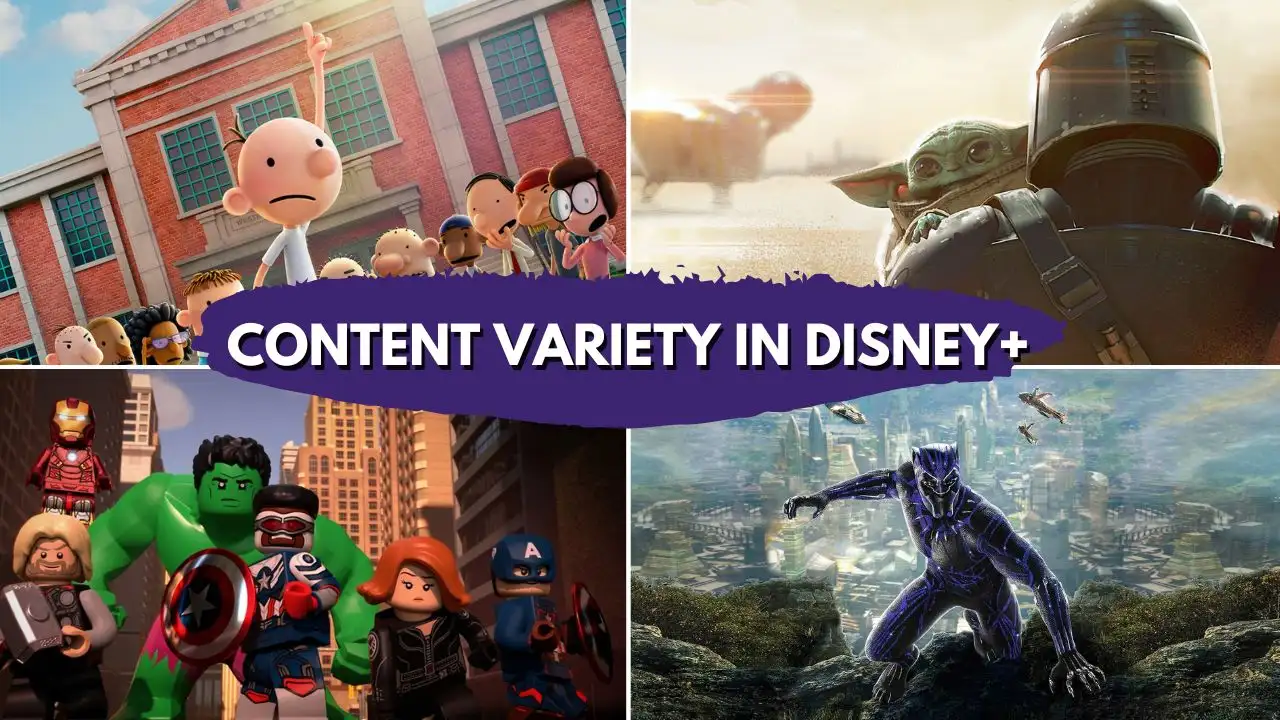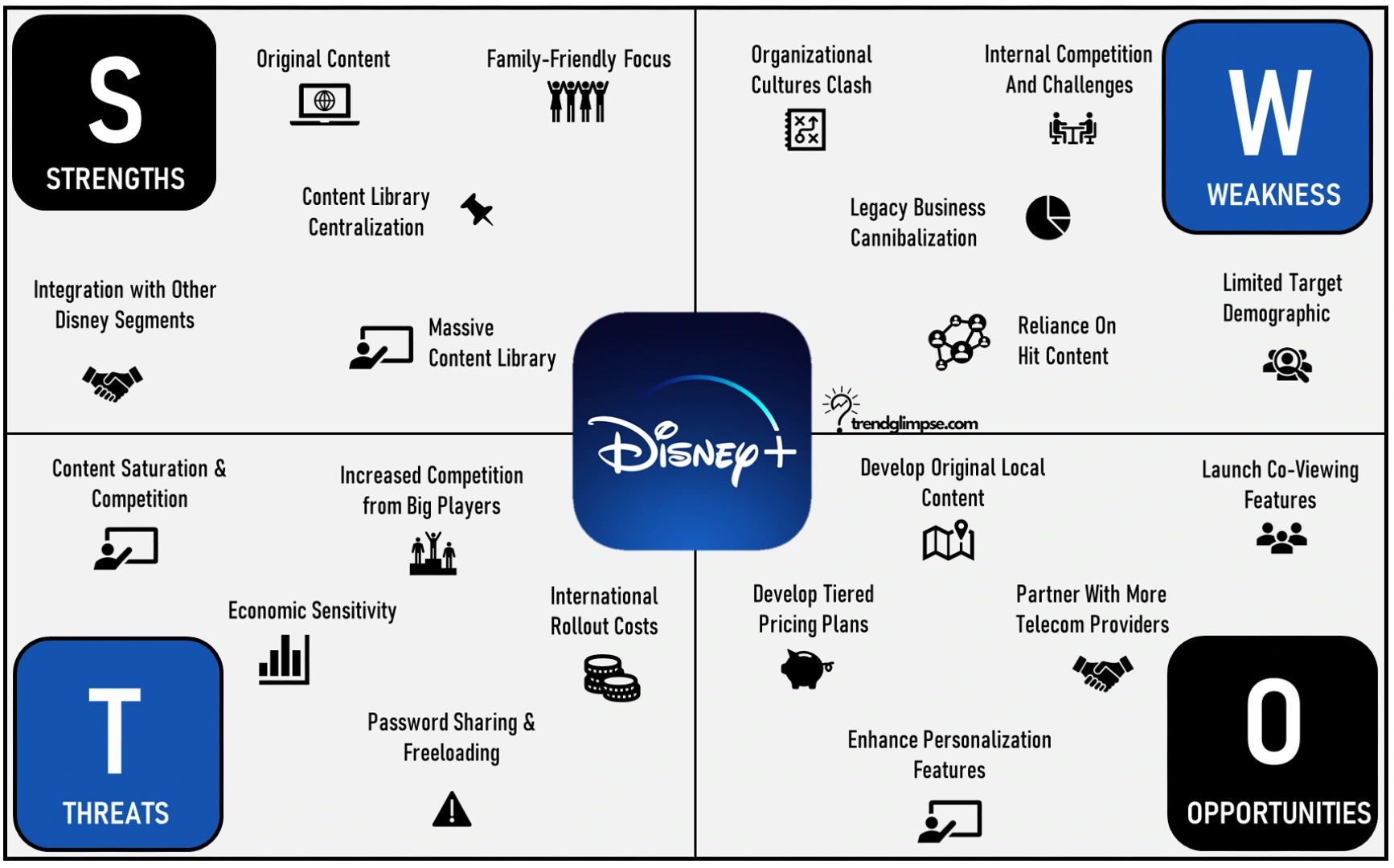An Overview of Disney Plus
Disney+ is the streaming service from The Walt Disney Company that launched in November 2019. It has quickly become a major player in the streaming market thanks to Disney’s vast library of content and intellectual property.
Headquarters: Los Angeles, California, United States
Industry: OTT Streaming
Owner: The Walt Disney Company
Current CEO: Bob Iger
Subscriber Count [2023]: ~150 Million
Website: disneyplus.com
Some key factors driving Disney+’s rapid revenue growth are its low monthly subscription cost, high-profile original shows and movies, and synergies with Disney’s other assets. By pricing it competitively, with its base plan starting at $7.99 per month, Disney+ has attracted over 150 million subscribers as of Q3 2023. Hit originals like The Mandalorian have also helped drive sign-ups. And bundling services like ESPN+ and Hulu has created a comprehensive streaming package for families.
A differentiating aspect of Disney+ is its focus on brands and franchises. From Marvel to Pixar to Star Wars, it offers dedicated hubs for popular Disney properties. This creates a unique value proposition for fans.
Disney, Pixar, Marvel, Star Wars, National Geographic, and Hulu
Competitors of Disney Plus
Netflix, Amazon Prime Video, Hulu, Apple TV+, HBO Max, Peacock, Paramount+, and Discovery+
Let’s take a look at Disney Plus and its position in the streaming industry through a SWOT Analysis framework. This Disney Plus SWOT Analysis will assess factors like Disney Plus’ extensive content library, branding, pricing, and target market.
Strengths of Disney Plus
Massive Content Library
Disney Plus boasts an absolutely massive content library spanning decades, which is a huge draw for subscribers. At launch, Disney+ already had nearly 500 films and over 7,500 TV episodes ready for streaming.
This includes Disney’s animated classics like Snow White and Aladdin, Pixar hits like Toy Story and Finding Nemo, Marvel blockbusters like Black Panther and Avengers: Endgame, and beloved Star Wars films. Not to mention all the content from National Geographic. This vast, nostalgic catalog attracts subscribers across generations. No other streaming service can match this depth and variety of content.
Original Content
In addition, Disney is investing heavily in high-quality original content exclusive to Disney+. Major originals like The Mandalorian and WandaVision have been hugely popular and have kept subscribers engaged. By making must-see original shows and movies that are only available on Disney+, it gives people more incentive to sign up and stay subscribed.
Disney has committed to spending more on originals, planning to release 100+ new titles per year. Between the expansive back catalog and slate of exclusives, Disney+ has unmatched content assets that serve as internal strengths. This focus on content is why Disney+ has grown so quickly to over 130 million subscribers in just 3 years since launching.
Fluid Integration of Disney+ with Other Disney Segments
A key strength of Disney+ is how it integrates fluidly with Disney’s other business segments to create a continuous loop of engagement. For example, park visitors can extend their magical Disney experience at home by subscribing to Disney+ for everyday Disney entertainment. Or a new Disney Princess movie in theaters might prompt families to visit the Disney Store for related toys and merchandise.
In-store advertising can then encourage the idea of actually meeting that princess character during a Disney Park visit, which leads to more merchandise purchases in the parks, and so on. Disney+ becomes the connecting thread across these experiences.
Competitors’ Content Libraries
Additionally, by centralizing so much family-friendly content into Disney+, it directly weakens competitors. Now Disney aims to make Disney+ the primary platform for accessing its films and shows, influencing overall market dynamics. Services like Netflix now lack that key Disney/Pixar/Marvel content. This library consolidation gives
Disney much more control over the distribution of its content assets. Rather than licensing out its content, Disney now uses it as a key driver for its own streaming service. This strategic move to bring so much coveted content under Disney’s roof makes Disney+ far more competitive in the streaming landscape. In summary, Disney has leveraged its strengths across business segments and content libraries to position Disney+ for continued growth and success.
Family-Friendly Focus
Disney+ has strategically differentiated itself by maintaining a strict focus on family-friendly PG content, and this is a major internal strength. While other streaming services like Netflix and HBO aim for adult audiences with TV-MA shows and R-rated movies, Disney+ offers entertainment that parents feel comfortable letting their kids watch. This gives Disney+ a distinct niche as the streaming service built for families.
Disney has cultivated a brand reputation spanning almost 100 years as the premier creator of animated films, wholesome comedies, and inoffensive programming suitable for all ages. Disney+ smartly aligns itself with that reputation, airing fun, colorful stories with positive themes and minimal adult content.

Weaknesses of Disney Plus
Limited Target Demographic
Disney+ offers a deep content library focusing heavily on family-friendly franchises like Marvel, Star Wars, Pixar, and Disney animated films. While this positions Disney+ as an appealing option for households with children, it limits the service’s addressable market. Adults without kids have less incentive to subscribe to Disney+, given its narrow content scope.
Competitors like Netflix and Hulu offer more adult-oriented programming, original content across genres, and a wider range of licensed films and shows. By not diversifying beyond kid/family content, Disney+ misses out on demand from non-family demographics. Expanding into more mature, diverse programming could draw in new demographics and increase Disney+’s subscriber base and growth ceiling. A family-first strategy gives Disney+ clear positioning but also inherently constrains its target audience and market potential.
Legacy Business Cannibalization
As viewers transition from traditional cable TV packages to streaming video, Disney+ may inadvertently cannibalize revenues from Disney’s existing cable channels like ESPN, ABC, Freeform, and The Disney Channel. Many programs from these channels are now accessible online via Disney+. Consumers may cut cable subscriptions or TV channel packages containing Disney networks if they can get equivalent content through the
Disney+ streaming app. While driving streaming growth, this could undermine Disney’s older distribution models and revenue streams. Disney needs to carefully balance content between protecting its cable TV business and fueling its streaming expansion. Unless strategically managed, growing Disney+’s library could simply shift Disney’s earning sources rather than expanding them.
Reliance on Hit Content
Disney+ has benefited from massive hits like Wakanda Forever to drive subscriptions. But relying too heavily on a few tentpole originals creates risk. If those breakout shows end their runs, Disney+ may see increased subscriber churn if it lacks a strong pipeline of new hit programming. This revenue volatility occurred at Netflix when they lost popular licensed shows.
Disney+ needs to consistently develop fresh original hits across Marvel, Star Wars, and other franchises to retain subscribers when current hits finale. It takes time to generate new pop culture phenomena. Lulls between hits could cause temporary dips in Disney+ subscriptions. A steady pipeline of new buzzworthy originals is required to smooth out this risk and ensure subscribers remain engaged during transitions between content cycles.
Internal Competition and Challenges
Disney must balance coordination and competition among its streaming services, Disney+, ESPN+, and Hulu. Each targets somewhat distinct audiences and content categories, avoiding direct overlap. However, for consumers with limited entertainment budgets, the choice of which Disney streaming service to prioritize could cannibalize sign-ups for the others.
Disney needs to carefully position and cross-promote its services to maximize combined subscribers. There is also a potential culture clash between the technology-focused streaming division and Disney’s traditional media businesses. Smooth collaboration and data sharing between these units is key but may prove challenging given differing approaches.
Organizational Cultures Clash
Disney faces a potential organizational culture clash between its traditional media business and its newer streaming division. The traditional film, TV, and cable units operate with a more old-school Hollywood culture. The streaming tech team functions in a more agile, digital-first manner. There are differences in workstyle, pace, and values across these units. However, close coordination between groups is vital for Disney+ success.
Content scheduling, data sharing, marketing partnerships, and other decisions require alignment. If the traditional media and streaming divisions become misaligned due to cultural differences, it could severely inhibit Disney’s transition to streaming dominance.

You Might Also Like – Chipotle SWOT Analysis
Opportunities For Disney Plus
Global Potential Through Strategic Expansion
Disney+ has a major growth opportunity by accelerating its global rollout, particularly in Latin America, Europe, and Asia. While Disney+ has seen strong adoption in core markets like the U.S., Canada and Australia, large swaths of the world remain untapped. By translating its content library into local languages, partnering with existing media distributors, and pricing competitively, Disney+ can gain first-mover advantage.
Each geographic market will require unique strategies to localize content, sway consumers away from established SVODs, and work with regulators. Investing to expand globally requires upfront costs but builds long-term loyalty in fast-growing entertainment markets abroad. With its universally recognizable brand and content IP, Disney+ is well positioned to emulate Netflix’s success in scaling internationally and becoming the de facto streaming platform in new regions.
Develop Original Local Content
As mentioned above, Disney+ can further attract international subscribers by investing in original content tailored to local markets. While Disney has premium global franchises, streaming viewers also crave shows and films made specifically for their country and culture. Hiring local writers, directors, and actors to produce exclusive Disney+ content can help viewers in places like India, Brazil, and continental Europe feel represented on the platform.
Adapting existing IP or developing fresh stories that appeal regionally demonstrates Disney’s commitment to creating local value, not just exporting American content abroad. However, producing local originals will require hiring personnel with knowledge of each distinct market. While costly, the differentiation can help Disney+ stand apart in crowded streaming fields outside the US.
Partner With More Telecom Providers
Disney+ can leverage partnerships with telecom companies to bundle the streaming service with cell phone plans and other internet and TV services as a customer acquisition strategy. For example, Charter Communications, Inc. and The Walt Disney Company announced that the ad-supported version of Disney+ is now available to Charter’s Spectrum TV Select customers at no extra cost. Additionally, Verizon offers a Disney Bundle, which includes Disney+, Hulu (with ads), and ESPN+ (with ads), for a promotional price.
Moreover, markets like India and Africa have seen rapid growth in mobile connectivity, presenting a chance to convert new smartphone users into Disney+ subscribers. Carriers can benefit by offering Disney+ as a perk to drive sales of their core connectivity products. Telecom partnerships provide wider distribution by embedding Disney+ into providers’ sales channels and platforms. However, revenue shares and contract terms must be structured favorably to ensure profitability for Disney+.
Enhance Personalization Features
To drive better streaming engagement, Disney+ should leverage data analytics and AI to provide users with a more personalized experience. Advanced recommendation algorithms that surface tailored content based on each subscriber’s unique interests, favorite genres, and historical viewing patterns can promote discovery and retention. Personalizing homepages, notifications, and suggested titles caters to individuals rather than one-size-fits-all.
Investing in these product capabilities requires dedicated data science and engineering talent. However, the benefit is deeper engagement as the platform feels customized to the end user versus a generic catalog. Done responsibly, personalized experiences reflect Disney’s focus on magic and individuality. Differentiating through relevance counters churn and builds affinity.
Develop Tiered Pricing Plans
Introducing an ad-supported plan at a lower price point gives budget-conscious households a more affordable entry point to Disney+ content. Conversely, a premium tier with enhanced features caters to users willing to pay more for added quality and exclusives. This pricing flexibility helps match cost to the value different groups of subscribers place on the service.
Disney+ can also leverage bundle pricing with Hulu and ESPN+ to create fuller content packages. Exploring different plans balances maximizing revenue from heavy users willing to spend more while also attracting cost-sensitive viewers through budget options. Pricing tiers allow Disney+ to cast a wider net across income levels rather than a rigid one-size-fits-all approach.
Launch Co-viewing Features
To become a social streaming destination, Disney+ should introduce co-viewing capabilities that allow remotely located users to synchronize their viewing and interact as if together in person. Friends and family, especially intergenerational ones, have always shared Disney experiences. By replicating co-viewing digitally, Disney+ can foster community, engagement, and viral sharing.
Coordinated playback controls, group chat, and simultaneous reaction streams evoke replicating movie theater or living room viewing parties online. Promoting virtual co-viewing experiences reflects Disney’s focus on togetherness and magic. Integrating social components provides a competitive edge over purely solitary streaming platforms. Bringing people together around Disney+ amplifies enjoyment and retention while driving organic subscriber referrals.
You Might Also Like – Starbucks SWOT Analysis
Threats for Disney Plus
Content Saturation and Competition
The explosion in streaming video services has dramatically increased the amount of high-quality original content competing for consumers’ attention. Leaders like Netflix and Hulu now face serious competition from new entrants, including Apple TV+, HBO Max, and Peacock. This creates subscriber fatigue; consumers are frustrated by having to pay for multiple services to access all their favorite shows.
Disney+ entered the market with huge built-in advantages from owning extensive libraries of popular movies and franchises. But as other deep-pocketed competitors spend billions creating exclusive original content, it becomes harder for Disney+ to stand out. Consumers with finite budgets make hard choices on which 2-3 services to pay for. Disney+ needs to ramp up investments in new original programming and leverage bundle deals with Hulu to make its service indispensable to subscribers flooded with options.
Password Sharing and Freeloading
Password sharing is an industry-wide problem largely ignored in the early years of streaming. Nearly one-third of US households use shared logins to watch Disney+ for free. This significantly limits Disney’s paid subscriber growth and revenue potential. Efforts to crack down on password sharing spark backlash, but ignoring the problem trains consumers to expect free access.
Disney+ needs to strike a delicate balance between allowing reasonable shared use to promote subscriptions while discouraging blatant freeloading. Options like requiring verification of primary residence or limiting the number of concurrent streams could restrict excessive sharing. Partnerships with broadband providers could help identify freeloaders. But heavy-handed anti-sharing tactics may alienate some users. Disney+ must be cautious to avoid PR disasters that tarnish its brand image.
International Rollout Costs
Disney+ faces heavy costs and uncertainty as it continues expanding globally. While broad international reach is critical for growth, many overseas markets lack the reliable broadband infrastructure, digital payment systems, and subscription streaming traditions of mature western regions. In countries like India, Disney+ must cater to consumers accustomed to low-cost, ad-supported content bundles.
Significant localization expenses are required for subtitles, dubbing, and cultural sensitivity edits. Effective marketing is also challenging, with Disney+ facing entrenched local players. The potential gains are enormous if Disney+ can win over developing countries with younger demographics. But profitability in these markets is far from guaranteed. Disney needs to balance fast global expansion with prudent spending on markets that prove viable.
Increased Competition
The streaming landscape grows more competitive by the day, as deep-pocketed streaming platforms are locked in an arms race for original content. Netflix alone is projected to spend over $13 billion on content this year. Amazon Prime and HBO Max also regularly shell out nine-figure production budgets to attract top talent. This drives up content costs across the industry. Disney+ boasts unmatched established franchises and intellectual property, but it still needs to shell out huge sums for new original programming to stand out.
Without matching its rivals’ content investments, Disney risks losing subscribers to competing services with hot new shows. The economic viability of streaming may falter if the number of players becomes unsustainable. But for now, Disney has little choice but to divert more resources into prestigious originals.
Economic Sensitivity
As a non-essential entertainment service, Disney+ is vulnerable to economic downturns that press consumers to cut back on discretionary spending. During recessions or periods of high inflation, consumers reevaluate their ongoing subscriptions. Services providing essential access, like broadband, tend to be retained, while consumers may rotate between discretionary streaming options like Disney+.
This results in subscriber churn and makes revenue growth harder to sustain in lean times. Disney+ saw a slowdown in new subscribers during 2022’s high inflation. An extended economic slump could depress growth for multiple quarters. Disney+ may need to expand bundle deals or introduce lower-priced, ad-supported plans to retain budget-conscious subscribers during downturns.
Conclusion
Looking at this Disney+ SWOT analysis, it’s clear the service has massive growth potential thanks to Disney’s extensive library, cross-promotional abilities, and brand equity.
To stay ahead in the streaming race, Disney+ should keep leveraging strengths like beloved franchises and diverse content while aggressively expanding worldwide. Ramping up original, culturally-resonant productions and maximizing cross-promotions across Disney’s unrivaled IP will also help Disney+ thrive as competition increases.
Capitalizing on these opportunities outlined in the Disney+ SWOT analysis will strengthen Disney’s position as an undisputed streaming leader.

I have always been fascinated by the inner workings of companies and industries. So I decided to study business to explore it more. My goal is to take all my research and turn it into cool stories that give people a better understanding of the business world.

